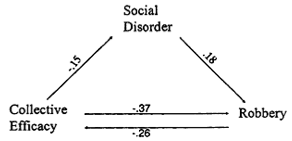
Felton Earls’ term for the single most important determinant of a neighborhood’s violent crime rate is “Collective Efficacy:” “Trust, reciprocity, and a willingness among people to look out for one another.”
“Our national ideology gets spun off in the direction of individualism,” says Earls. “But maybe the survival of our country demands that we balance that strong ethic with the admission that we’re in it together.”
It’s nice when $50+ Million of public health research returns something that’s solidly useful (example article: Science (pdf)}. “It is far and away the most important [crime] research insight in the last decade,” said Jeremy Travis, director of the National Institute of Justice from 1994 to 2000. “I think it will shape policy for the next generation.”
This same research program has finally shown the Broken Windows to be just a bunch of fuzzy thinking. Broken Windows was a very popular hypothisis that crime arises from disorder; for example the unrepaired broken window. It’s popular with authoritarians since it licenses them to demand that other people clean their desks and gives them an excuse to arrest the shabby or homeless. It confounds cause and effect.
This nice peice of research (pdf) both fails to substantiate the silly idea but also demonstrates that collective efficacy is a much more valuable predictive variable. Meanwhile the research is delightful because they collected so much data so very carefully.
(See also this:NY Time’s Article).
Pingback: Ascription is an Anathema to any Enthusiasm › Broken Windows :: Alice’s Resturant
I have seen Collective Efficacy work well in my company, but I cannotentirely dismiss the “Broken Windows” theory on the basis that “It confounds cause and effect.”
To me it’s like Cognitive Behavior Therapy, and I’m seeing it work too.
http://en.wikipedia.org/wiki/Cognitive_Behavior_Therapy
“A basic concept in CBT treatment of anxiety disorders is in vivo exposure—a gradual exposure to the actual, feared stimulus. This treatment is based on the theory that the fear response has been classically conditioned and that avoidance positively reinforces and maintains that fear.”
“Through exposure to the stimulus, this conditioning can be unlearned; this is referred to as extinction and habituation.”
You can see there is a light negative corrolation between social disorder and both robbery and collective efficacy. But if your looking for a lever to pull then working on collective efficacy is more effective. And notice that there isn’t a tie from level of social order to the efficacy; only the other way around.
It’s cool that modern stats can tease these things out with some confidence.